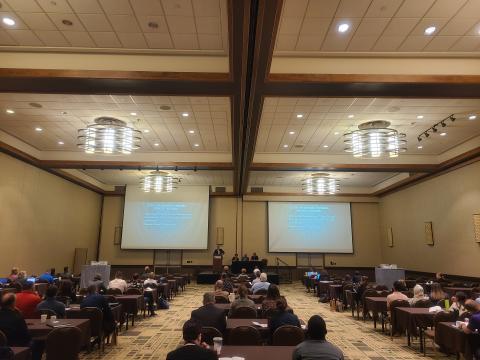The 2023 Nebraska Water Conference, “Managing water resources in urban Nebraska: learning from the past to prepare for the future,” brought together global researchers, engineers, and water professionals in October to discuss crucial water issues in Nebraska’s cities.
The conference marks the end of the journey following the Platte River since the 2020 conference intended to be held in Scottsbluff and ending in Omaha in 2023. This conference featured expert panelists and speakers that discussed current natural resource challenges faced by Lincoln and Omaha while providing advice on the future of water management in eastern Nebraska.
“Holding the Nebraska Water Conference in a different part of Nebraska each year allows us to focus on topics that are relevant to different parts of the state,” said Ann Briggs, Nebraska Water Center Public Relations and Engagement Coordinator. “After following the Platte River the past few years, it made sense to come to Omaha in 2023 and focus on urban water management. Lincoln and Omaha manage water very differently from the rest of the state, so we were excited to bring in local experts to share their knowledge with attendees.”
Attendees had the opportunity to tailor their conference experience to what best fit their interests by attending a variety of breakout sessions and keynote speakers.
Some conference favorites included Tools for Water Management I and II which discussed well monitoring research, the Nebraska Clearinghouse database, the Eastern Nebraska Water Resources Assessment project and more. Attendees also enjoyed hearing an update about Lincoln’s Water 2.0 Project to find a second reliable water supply from Steve Owen, City of Lincoln.
The University of Nebraska-Lincoln Institute of Agriculture and Natural Resources sponsored a poster competition for students at the conference. Britt Fossum received third place for her poster titled, “Biochar application into existing no-till and cover crop system for enhanced soil nutrient retention and carbon storage.” Her project focused on understanding the effects of biochar application and winter cover crops on soil carbon storage and water and nitrogen retention under field conditions. Sinan Rasiya Koya received second place for his research, “Causal drivers of rain-on-snow events in North America,” which analyzed rain-on-snow events from 1951 to 2022 to determine causational factors. First place was awarded to Yvon Ukwishaka for “Redox-driven transformation of inorganic nitrogen species across the vadose zone: insights from column experiment.” Ukwishaka’s research sought to analyze inorganic nitrogen redox reactions in the vadose zone to “predict and prevent nitrate groundwater contamination in heavily irrigated areas.” Congratulations to all three winners.
On the second day of the Water Conference, attendees chose to attend one of four site tours that showed attendees different water projects, research, and management locations around Omaha.
The Urban Water Projects site tour hosted by JEO Consulting Group took attendees to Gretna, NE, where they showed the newly opened Gretna Crossing Park which includes a fishing pond, amphitheater, athletic fields, dog run, water park, and more. This is next to the Papio Missouri River NRD WP-4 Dam project that is projected to finish in late 2024. JEO is building a high-hazard dam in Gretna to help prevent new housing developments in the area from potential floods. This dam will include boat docks and fishing piers and will provide new recreational activities for the area. This tour included an extra stop at Adams Park, a previous creek restoration project by the City of Omaha.
Attendees toured the Platte West Water Treatment Plant and met with managers from the Florence, Platte West, and Platte South Facilities to see the water treatment process. Hosted by the Metropolitan Utilities District, attendees learned about the importance of this plant as a pillar in the “Triangle of Reliability” which provides consistent water to the Omaha metro area and the Papio-Missouri NRD. The plant takes in primarily ground water and can treat over 100 million gallons of water per day. Attendees witnessed the treatment process and saw where the water is brought in, how it is treated, and how it is piped to homes. All water in the plant is treated with some of it softened. The softened and fully treated water is combined before it is sent to homes for a partially softened result.
The University of Nebraska-Omaha research tour visited Glacier Creek Preserve and Elmwood Park. Glacier Creek Preserve is a valuable research site because it includes an entire sub-watershed within its boundaries. The sub-watershed moves through various ecosystems including restored tallgrass prairie and land previously used for agriculture. Dr. David Manning, Assistant Professor of Biology, and Dr. Tom Bragg, Glacier Creek Preserve Director, led a hike through the preserve to experience the ecosystems and see first-hand the research sites that are used to understand different ways water interacts with the sub-watershed. Attendees also visited Elmwood Park. UNO researchers and classes utilize Elmwood Park because of its spring fed creeks and urban characteristics. These two research sites provide vastly different opportunities for both researchers and students at UNO that are focused on water.
“The site tours gave attendees the opportunity to get out of a conference room and experience the different research and management methods we had discussed the previous day,” Briggs said. “We couldn’t have organized four separate tours without our partner organizations taking the lead on hosting, and we appreciate their involvement in our conference.”
The Nebraska Water Conference celebrates the continuous ingenuity of water research while fostering a deeper understanding of water and its many beneficial uses for the state. The future of water management in urban Nebraska is bright.
To learn more about future conferences, visit watercenter.unl.edu

